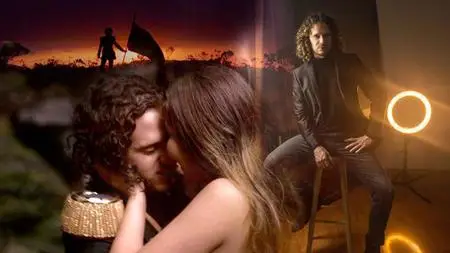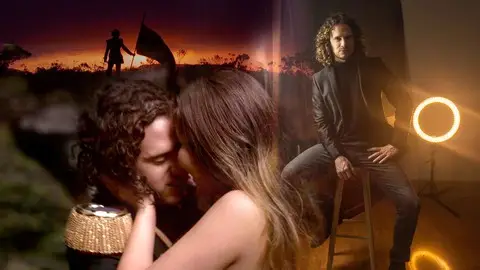Film Acting Course - How To Become A Real Film Actor
Published 11/2022
MP4 | Video: h264, 1280x720 | Audio: AAC, 44.1 KHz
Language: English | Size: 4.99 GB | Duration: 4h 4m
Published 11/2022
MP4 | Video: h264, 1280x720 | Audio: AAC, 44.1 KHz
Language: English | Size: 4.99 GB | Duration: 4h 4m
Students will learn step by step everything they need to perform in front of the camera and make a living of it.
What you'll learn
Students will learn to find the truth as a mechanism that creates emotions in interpretation: the Stanislavski, Adler, and Meisner techniques.
Students will learn to differentiate between theater and film acting language, in order to understand the true nature of film acting.
By watching the best examples on screen students will learn through exercises to master subtle gestures the challenges of the deep listening process that an act
Students will learn how to prepare your videobook to get into an acting agency and get auditions. Students will learn how to properly selftape for castings.
Students will learn what the process of building a character is like. In this lesson you will learn about the journey of a character through a dramatic arc.
Requirements
No previous experience is necessary
Description
Specialized course in film acting. BEY ATELIERA course designed to learn step by step how to use the body, voice and emotion as an instrument of artistic expression; you just need to use your imagination and emotion to make your way in the world of acting."I have designed this course based on my experience working in front of the camera as an actor and behind the camera as a film director and screenwriter. Through these lessons you will learn not only what an actor must do to represent a character, but also everything that a film director is expecting from you as an actor" Baudilio Bey PerezStudents will learn to differentiate between theater and film acting language, in order to understand the true nature of film acting.Students will learn to be aware of the nature of their own body to use it as an instrument of dramatic expression.Students will learn to find the truth as a mechanism that creates emotions in interpretation. In this process you will learn the Stanislavski, Adler, and Meisner Technique to master emotions under any circumstance in front of the camera.Students will learn to adapt to the physical requirements of a character, as well as the discipline and challenges that any film project requires.Students will learn the value of an actor's intellectual ability.Students will learn what the process of building a character is like. In this lesson students will learn about the journey of a character through a dramatic arc and students will also learn the difference between the protagonist, main character and supporting character.By watching the best examples on screen students will learn through exercises to master subtle gestures, to face the challenges of our body in a scene, as well as to interact between actors for romantic scenes.Students will learn how to prepare a videobook to get into an acting agency and get auditions. Students will learn how to properly selftape for online castings.Students will learn the value of social relationships in the career of the actor to make your way in the professional world of cinema."During the learning process we learn the contents by seeing some of my fiction works which you will be able to see completely at the end of the course" Baudilio Bey PerezAn opportunity to become a movie actor, no matter what you do, you just need to use your imagination and emotion to make your way in the world of acting. TABLE OF CONTENTSLESSON 1 - The differences between Theater Acting and Film Acting: In this lesson we will address the differences between the language used in the movies and the language used in the theater. The objective of this lesson is to lay the foundations in which you will delve into acting for cinema, understanding the signifiers of this artistic form and its evolution from theater plays.LESSON 2 - Body Awareness: In this lesson you will learn to be aware that the only instrument we are going to have to act is our body. By deeply understanding the unique nature of our body we will be able to determine the natural behavior of our body when experiencing each emotion and circumstance.LESSON 3 - The importance of intellectual skills: In this lesson you will learn the importance of education for actors when facing an acting challenge. Formal and comprehensive education (in any area) will allow the actor to have tools and general knowledge to portray a character.LESSON 4 - Emotions and truth - Stanislavski & Adler: The emotion and the truth. Connecting with emotions is essential to portray a character. But there is no single technique to achieve it and you must know all the formal techniques to do it. In this first lesson you will learn on the one hand the approaches of Konstantin Stanislavski (1863-1938) who based his technique on affective memory and on the other hand Stella Adler (1901-1992) who based himself on the use of imagination to make a true interpretation.LESSON 5 - Emotions and Truth - Meisner: In this lesson we are going to address the technique of Sanford Meisner (1905-1997) which consists of understanding the reality and world in which the character lives to represent it faithfully. In this lesson we are going to address the technique of Sanford Meisner (1905-1997) which consists of understanding the reality and world in which the character lives to represent the character faithfully. On the other hand, for the actors, it is necessary to achieve a deep listening process that is not only limited to knowing how to listen to the actor with whom we are going to interact on the scene, but also to listen to the character in the story.LESSON 6 - Emotions and Truth - Example: In this lesson I will show you an example of a scene from one of my works where I apply both the Meisner technique and the Stanislavski technique. The objective of this lesson is that you can understand the difficulties that can arise in the setting when acting under the unpredictable conditions.LESSON 7 - The Contemplation: By understanding, feeling and observing cinematic examples on screen we will see how to approach the 3 stages of contemplation. A practical lesson to put into practice and understand the contents of the course.LESSON 8 - Differences Between Acting for Theater and Acting for Cinema - Example: A lesson to see on screen the evolution of acting language during the 20th century. On the other hand, it will allow us to see with examples how is the listening evolution process in a scene.LESSON 9 - Character's Journey - Types Of Characters - Dramatic Arc: In this lesson the student will learn the differences between the protagonist and the main character in terms of writing. Understanding what a dramatic arc is is crucial to honestly listening to the other character. On the other hand, as actors, we need to know what the narrative nature of a film story is.LESSON 10 - Dramatic Arc - Structure (Screenwriting course Lesson): An extra lesson of the screenwriting course so that the student knows what a dramatic arc consists of and the Aristotelian structure of a story.LESSON 11 - What does a Screenplay look like?: An extra lesson of the screenwriting course so that the student knows what a screenplay looks like on the screen.LESSON 12 - Disabled Exercise: In this scene you will see examples of how the circumstances in which our body finds itself will affect our performance and the emotions inherent to it.LESSON 13 - Romantic Scenes: This lesson aims to create awareness about the nature of romantic scenes and their stories when it comes to acting. It is necessary to have the necessary maturity to deal with this type of project so as not to spoil the film projects.LESSON 14 - Example of Love Scene: In this scene we will see on screen how to achieve a realistic and convincing love performance. The student will see with examples how to build an emotionally powerful love scene.LESSON 15 - Casting & Agency: In this lesson you will understand how casting agencies work. The objective of this lesson that I know mainly the two types of agencies that you should enter when you are starting your acting career (advertising acting agencies and fiction agencies).LESSON 16 - The Importance of Physical Training: The objective of this lesson is that you learn the importance of taking care of your body and your health to tackle any film project. LESSON 17 - Social Relationships: Social relationships are a fundamental tool to open a path in the acting world. We need to achieve the greatest amount of quality work, in order to have a videobook that allows us to enter a qualified agency. We cannot wait for an opportunity to appear, we must look for it or try to create it.LESSON 18 & 19 EXAMPLE SHORT FILMS
Overview
Section 1: INDEX
Lecture 1 INDEX
Section 2: MODULE I Fundamentals
Lecture 2 The differences between Theater Acting and Film Acting
Lecture 3 Body Awareness
Lecture 4 The importance of intellectual skills
Section 3: MODULE II Theory
Lecture 5 Emotions and truth - Stanislavski & Adler
Lecture 6 Emotions and Truth - Meisner
Lecture 7 Emotions and Truth - Example
Lecture 8 The Contemplation
Lecture 9 Differences Between Acting for Theater and Acting for Cinema - Example
Lecture 10 Character's Journey - Types Of Characters - Dramatic Arc
Lecture 11 Dramatic Arc - Structure (Screenwriting course Lesson)
Lecture 12 What does a Screenplay look like?
Lecture 13 Disabled Exercise
Lecture 14 Romantic Scenes
Lecture 15 Example of Love Scene
Section 4: Make Ready!
Lecture 16 Casting & Agency
Lecture 17 The Importance of Physical Training
Lecture 18 Social Relationships
Section 5: KAROUWA
Lecture 19 KAROUWA
Lecture 20 Cross Under The Moon
Professional Actors,Theater Actors,Acting Lovers,Film Directors



